Synthesis of a Novel Linear α, ω-Di (Chloro Phosphoramide) Polydimethylsiloxane and Its Applications in Improving Flame-Retardant and Water-Repellent Properties of Cotton Fabrics
Abstract
:1. Introduction
2. Materials and Methods
2.1. Materials
2.2. Preparation of Ethyldichlorophosphate
2.3. Preparation of PDMS-2NH2
2.4. Preparation of CPN-PDMS
2.5. Preparation of Treated Cotton Fabrics
2.6. Measurements and Characterizations
3. Results and Discussion
3.1. Characterization of CPN-PDMS
3.2. Flame Retardant and Mechanical Properties
3.3. Thermal Degradation Stability
3.4. Combustion Behaviors
3.5. Water Repellency
3.6. Surface morphology
3.7. Elemental Analysis
3.8. FTIR Analysis of Char Layers After Combustion
3.9. Washing Durability
4. Conclusions
Supplementary Materials
Author Contributions
Funding
Conflicts of Interest
References
- Chen, S.S.; Li, X.; Li, Y.; Sun, J.Q. Intumescent Flame-Retardant and Self-Healing Superhydrophobic Coatings on Cotton Fabric. ACS Nano 2015, 9, 4070–4076. [Google Scholar] [CrossRef] [PubMed]
- Cui, Y.F.; Xing, Z.J.; Yan, J.; Lu, Y.H.; Xiong, X.Q.; Zheng, L.J. Thermosensitive Behavior and Super-Antibacterial Properties of Cotton Fabrics Modified with a Sercin-NIPAAm-AgNPs Interpenetrating Polymer Network Hydrogel. Polymers 2018, 10, 818. [Google Scholar] [CrossRef] [PubMed]
- Zhang, H.; Lu, J.L.; Yang, H.Y.; Yang, H.; Lang, J.Y.; Zhang, Q.Q. Synergistic Flame-Retardant Mechanism of Dicyclohexenyl Aluminum Hypophosphite and Nano-Silica. Polymers 2019, 11, 1211. [Google Scholar] [CrossRef] [PubMed]
- Chen, D.Z.; Chen, F.X.; Zhang, H.W.; Yin, X.Z.; Zhou, Y.S. Preparation and characterization of novel hydrophobic cellulose fabrics with polyvinylsilsesquioxane functional coatings. Cellulose 2016, 23, 941–953. [Google Scholar] [CrossRef]
- Dong, C.H.; Lu, Z.; Wang, P.; Zhu, P.; Li, X.C.; Sui, S.Y.; Zhang, L.; Liu, J. Flammability and thermal properties of cotton fabrics modified with a novel flame retardant containing triazine and phosphorus components. Text. Res. J. 2017, 87, 1367–1376. [Google Scholar] [CrossRef]
- Hou, A.Q.; Zhang, C.X.; Wang, Y.Y. Preparation and UV-protective properties of functional cellulose fabrics based on reactive azobenzene Schiff base derivative. Carbohydr. Polym. 2012, 87, 284–288. [Google Scholar] [CrossRef]
- Yang, C.Q.; He, Q.L. Applications of micro-scale combustion calorimetry to the studies of cotton and nylon fabrics treated with organophosphorus flame retardants. J. Anal. Appl. Pyrol. 2011, 91, 125–133. [Google Scholar] [CrossRef]
- Dogan, M. Thermal stability and flame retardancy of guanidinium and imidazolium borate finished cotton fabrics. J. Therm. Anal. Calorim. 2014, 118, 93–98. [Google Scholar] [CrossRef]
- El-Shafei, A.; Abou-Okeil, A. ZnO/carboxymethyl chitosan bionano-composite to impart antibacterial and UV protection for cotton fabric. Carbohydr. Polym. 2011, 83, 920–925. [Google Scholar] [CrossRef]
- Chen, S.G.; Chen, S.J.; Jiang, S.; Xiong, M.L.; Luo, J.X.; Tang, J.N.; Ge, Z.C. Environmentally Friendly Antibacterial Cotton Textiles Finished with Siloxane Sulfopropylbetaine. ACS Appl. Mater. Interfaces 2011, 3, 1154–1162. [Google Scholar] [CrossRef]
- Alongi, J.; Ciobanu, M.; Malucelli, G. Sol-gel treatments for enhancing flame retardancy and thermal stability of cotton fabrics: Optimisation of the process and evaluation of the durability. Cellulose 2011, 18, 167–177. [Google Scholar] [CrossRef]
- Yang, J.; Pu, Y.; Miao, D.G.; Ning, X. Fabrication of Durably Superhydrophobic Cotton Fabrics by Atmospheric Pressure Plasma Treatment with a Siloxane Precursor. Polymers 2018, 10, 460. [Google Scholar] [CrossRef]
- Xie, K.L.; Gao, A.Q.; Zhang, Y.S. Flame retardant finishing of cotton fabric based on synergistic compounds containing boron and nitrogen. Carbohydr. Polym. 2013, 98, 706–710. [Google Scholar] [CrossRef]
- Horrocks, A.R. Textile flammability research since 1980-Personal challenges and partial solutions. Polym. Degrad. Stab. 2013, 98, 2813–2824. [Google Scholar] [CrossRef]
- Xiong, J.F.; Wang, Q.F.; Peng, P.; Shi, J.; Wang, Z.Y.; Yang, C.L. Design, Synthesis, and Characterization of a Potential Flame Retardant Poly(lactic acid-co-pyrimidine-2,4,5,6-tetramine) via Direct Melt Polycondensation. J. Appl. Polym. Sci. 2014, 131, 40275. [Google Scholar] [CrossRef]
- Edwards, B.; Rudolf, S.; Hauser, P.; El-Shafei, A. Preparation, Polymerization, and Performance Evaluation of Halogen-Free Radiation Curable Flame Retardant Monomers for Cotton Substrates. Ind. Eng. Chem. Res. 2015, 54, 577–584. [Google Scholar] [CrossRef]
- Przybylak, M.; Maciejewski, H.; Dutkiewicz, A.; Wesolek, D.; Wladyka-Przybylak, M. Multifunctional, strongly hydrophobic and flame-retarded cotton fabrics modified with flame retardant agents and silicon compounds. Polym. Degrad. Stab. 2016, 128, 55–64. [Google Scholar] [CrossRef]
- Zhang, B.T.; Liu, B.L.; Deng, X.B.; Cao, S.S.; Hou, X.H.; Chen, H.L. A novel approach for the preparation of organic-siloxane oligomers and the creation of hydrophobic surface. Appl. Surf. Sci. 2007, 254, 452–458. [Google Scholar] [CrossRef]
- Chang, S.C.; Slopek, R.P.; Condon, B.; Grunlan, J.C. Surface Coating for Flame-Retardant Behavior of Cotton Fabric Using a Continuous Layer-by-Layer Process. Ind. Eng. Chem. Res. 2014, 53, 3805–3812. [Google Scholar] [CrossRef]
- Mohamed, A.L.; El-Sheikh, M.A.; Waly, A.I. Enhancement of flame retardancy and water repellency properties of cotton fabrics using silanol based nano composites. Carbohydr. Polym. 2014, 102, 727–737. [Google Scholar] [CrossRef]
- Gaan, S.; Sun, G.; Hutches, K.; Engelhard, M.H. Effect of nitrogen additives on flame retardant action of tributyl phosphate: Phosphorus-nitrogen synergism. Polym. Degrad. Stab. 2008, 93, 99–108. [Google Scholar] [CrossRef]
- Alongi, J.; Colleoni, C.; Malucelli, G.; Rosace, G. Hybrid phosphorus-doped silica architectures derived from a multistep sol-gel process for improving thermal stability and flame retardancy of cotton fabrics. Polym. Degrad. Stab. 2012, 97, 1334–1344. [Google Scholar] [CrossRef]
- Liu, L.X.; Pan, Y.; Wang, Z.; Hou, Y.B.; Gui, Z.; Hu, Y. Layer-by-Layer Assembly of Hypophosphorous Acid-Modified Chitosan Based Coating for Flame-Retardant Polyester-Cotton Blends. Ind. Eng. Chem. Res. 2017, 56, 9429–9436. [Google Scholar] [CrossRef]
- Wang, S.; Sui, X.F.; Li, Y.Z.; Li, J.W.; Xu, H.; Zhong, Y.; Zhang, L.P.; Mao, Z.P. Durable flame retardant finishing of cotton fabrics with organosilicon functionalized cyclotriphosphazene. Polym. Degrad. Stab. 2016, 128, 22–28. [Google Scholar] [CrossRef]
- Vasiljevic, J.; Hadzic, S.; Jerman, I.; Cerne, L.; Tomsic, B.; Medved, J.; Godec, M.; Orel, B.; Simoncic, B. Study of flame-retardant finishing of cellulose fibres: Organic-inorganic hybrid versus conventional organophosphonate. Polym. Degrad. Stab. 2013, 98, 2602–2608. [Google Scholar] [CrossRef]
- Dong, C.H.; Lu, Z.; Zhang, F.J.; Zhu, P.; Wang, P.; Che, Y.; Sui, S.Y. Combustion behaviors of cotton fabrics treated by a novel nitrogen- and phosphorus-containing polysiloxane flame retardant. J. Therm. Anal. Calorim. 2016, 123, 535–544. [Google Scholar] [CrossRef]
- Lin, D.; Zeng, X.; Li, H.; Lai, X.; Wu, T. One-pot fabrication of superhydrophobic and flame-retardant coatings on cotton fabrics via sol-gel reaction. J. Colloid Interface Sci. 2019, 533, 198–206. [Google Scholar] [CrossRef]
- Wang, D.F.; Zhong, L.; Zhang, C.; Zhang, F.X.; Zhang, G.X. A novel reactive phosphorous flame retardant for cotton fabrics with durable flame retardancy and high whiteness due to self-buffering. Cellulose 2018, 25, 5479–5497. [Google Scholar] [CrossRef]
- Castellano, A.; Colleoni, C.; Iacono, G.; Mezzi, A.; Plutino, M.R.; Malucelli, G.; Rosace, G. Synthesis and characterization of a phosphorous/nitrogen based sol-gel coating as a novel halogen- and formaldehyde-free flame retardant finishing for cotton fabric. Polym. Degrad. Stab. 2019, 162, 148–159. [Google Scholar] [CrossRef]
- Qi, J.J.; Wen, Q.Z.; Zhu, J.H.; He, T.F. Synthesis of a novel intumescent flame retardant based on phosphorus, nitrogen, and silicone, and application in VMQ. J. Therm. Anal. Calorim. 2019, 137, 1549–1557. [Google Scholar] [CrossRef]
- Liu, M.S.; Huang, S.; Zhang, G.X.; Zhang, F.X. An efficient anti-flaming phosphorus-containing guanazole derivative for cotton fabric. Cellulose 2019, 26, 2791–2804. [Google Scholar] [CrossRef]
- Lin, D.M.; Zeng, X.R.; Li, H.Q.; Lai, X.J. Facile fabrication of superhydrophobic and flame-retardant coatings on cotton fabrics via layer-by-layer assembly. Cellulose 2018, 25, 3135–3149. [Google Scholar] [CrossRef]
- Xu, Z.L.; Miyazaki, K.; Hori, T. Fabrication of polydopamine-coated superhydrophobic fabrics for oil/water separation and self-cleaning. Appl. Surf. Sci. 2016, 370, 243–251. [Google Scholar] [CrossRef]
- Li, S.N.; Zhong, L.; Huang, S.; Wang, D.F.; Zhang, F.X.; Zhang, G.X. A novel flame retardant with reactive ammonium phosphate groups and polymerizing ability for preparing durable flame retardant and stiff cotton fabric. Polym. Degrad. Stab. 2019, 164, 145–156. [Google Scholar] [CrossRef]
- Jiang, Z.M.; Li, H.; He, Y.W.; Liu, Y.; Dong, C.H.; Zhu, P. Flame retardancy and thermal behavior of cotton fabrics based on a novel phosphorus-containing siloxane. Appl. Surf. Sci. 2019, 479, 765–775. [Google Scholar] [CrossRef]
- Qin, H.L.; Li, X.F.; Zhang, X.L.; Guo, Z.G. Preparation and performance testing of superhydrophobic flame retardant cotton fabric. New J. Chem. 2019, 43, 5839–5848. [Google Scholar] [CrossRef]
- Rosace, G.; Castellano, A.; Trovato, V.; Iacono, G.; Malucelli, G. Thermal and flame retardant behaviour of cotton fabrics treated with a novel nitrogen-containing carboxyl-functionalized organophosphorus system. Carbohydr. Polym. 2018, 196, 348–358. [Google Scholar] [CrossRef]
- Li, S.S.; Lin, X.H.; Liu, Y.; Li, R.; Ren, X.H.; Huang, T.S. Phosphorus-nitrogen-silicon-based assembly multilayer coating for the preparation of flame retardant and antimicrobial cotton fabric. Cellulose 2019, 26, 4213–4223. [Google Scholar] [CrossRef]
- Zhou, T.C.; He, X.M.; Guo, C.; Yu, J.; Lu, D.L.; Yang, Q. Synthesis of a novel flame retardant phosphorus/nitrogen/siloxane and its application on cotton fabrics. Text. Res. J. 2015, 85, 701–708. [Google Scholar] [CrossRef]


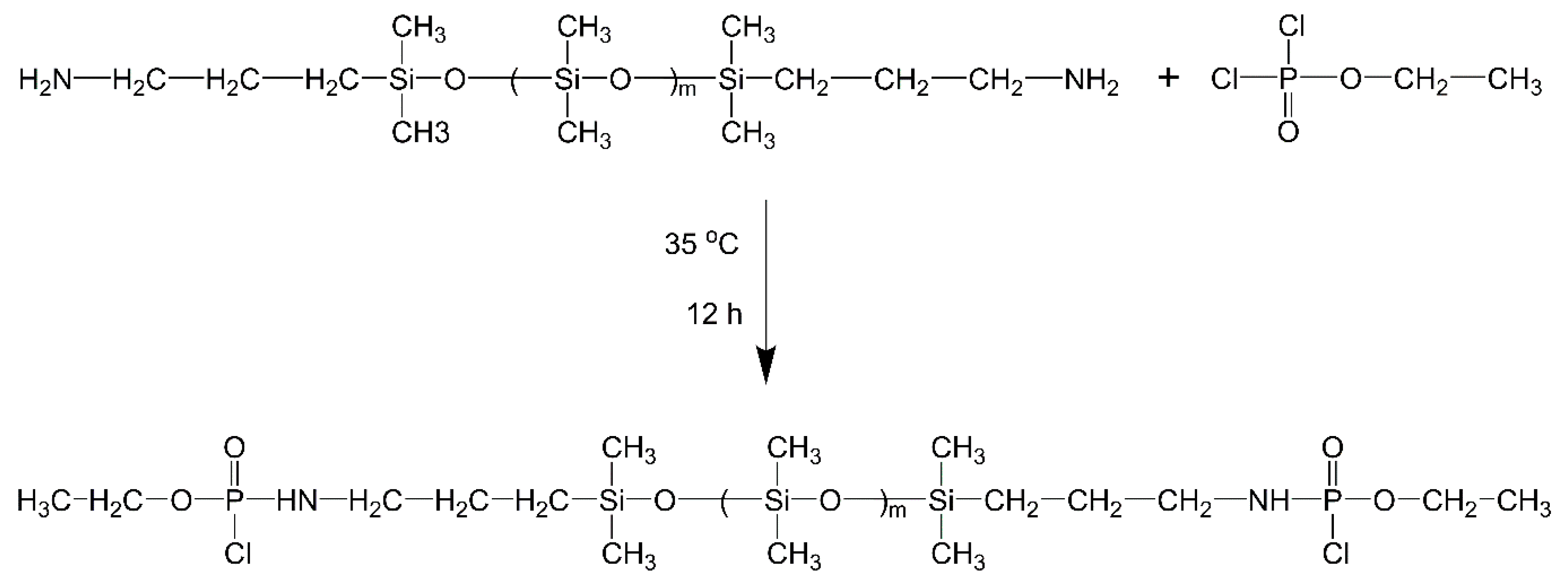
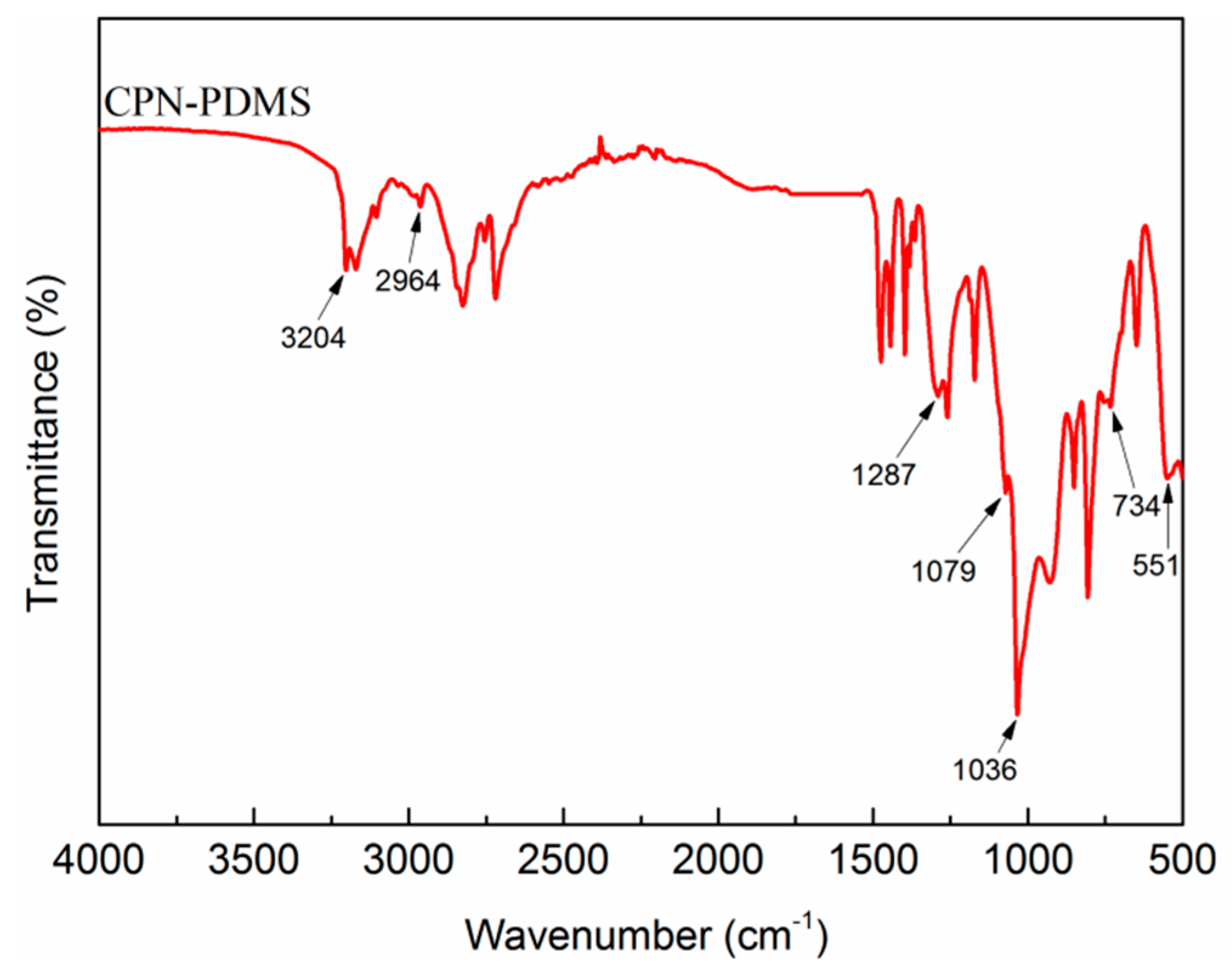
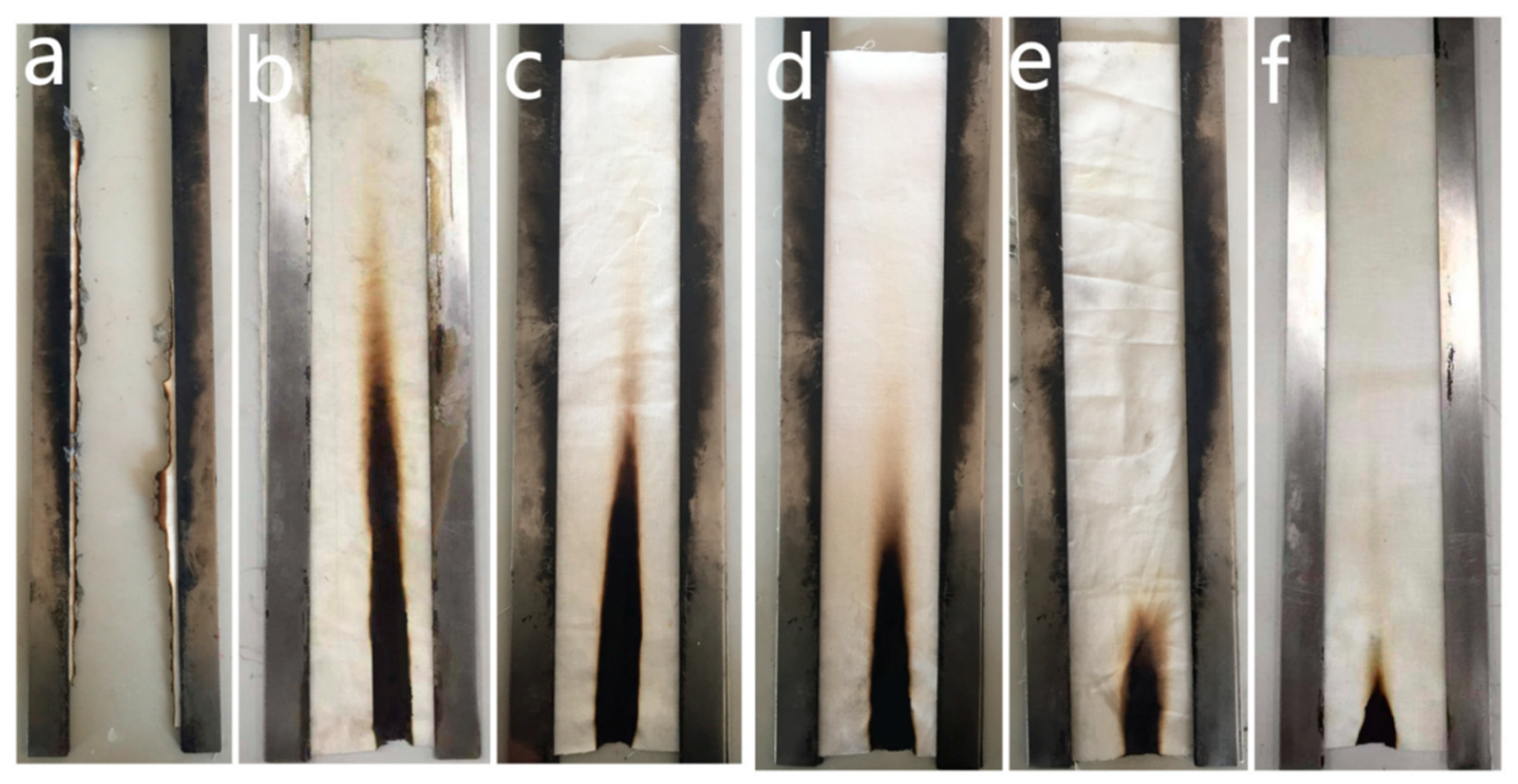
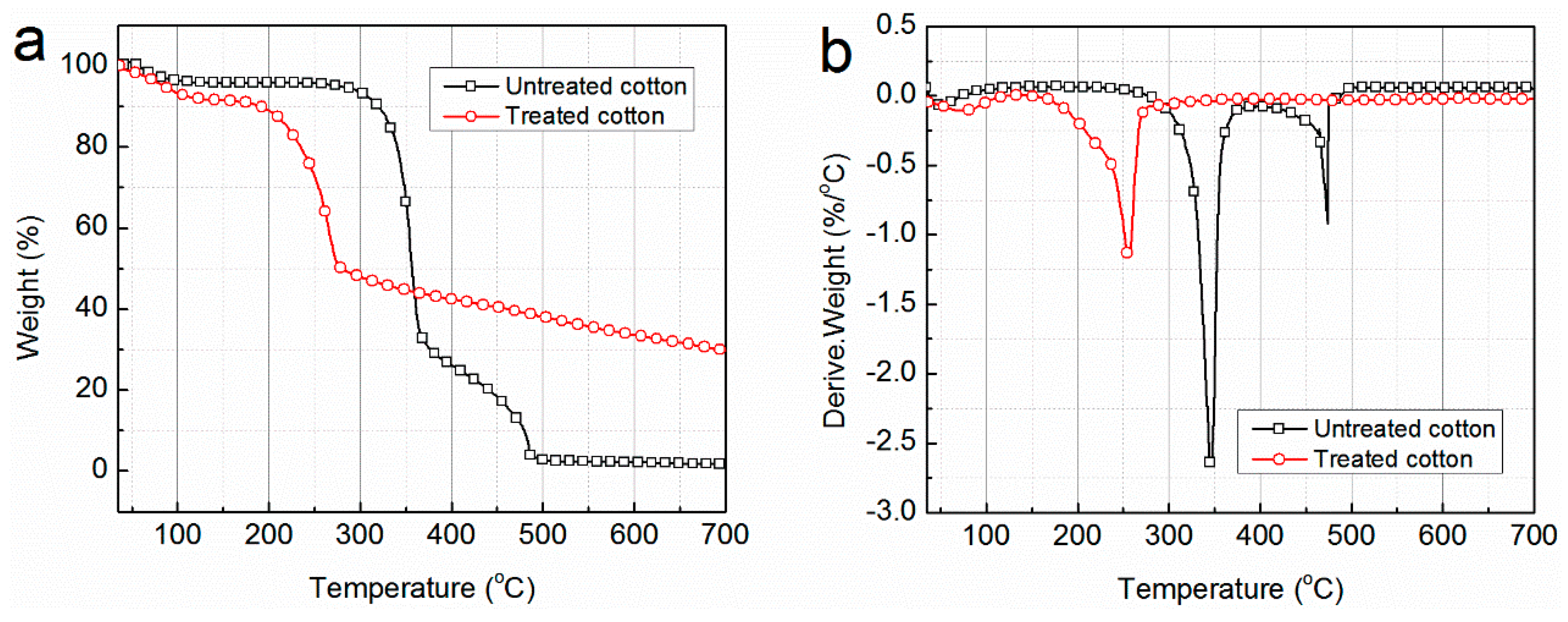


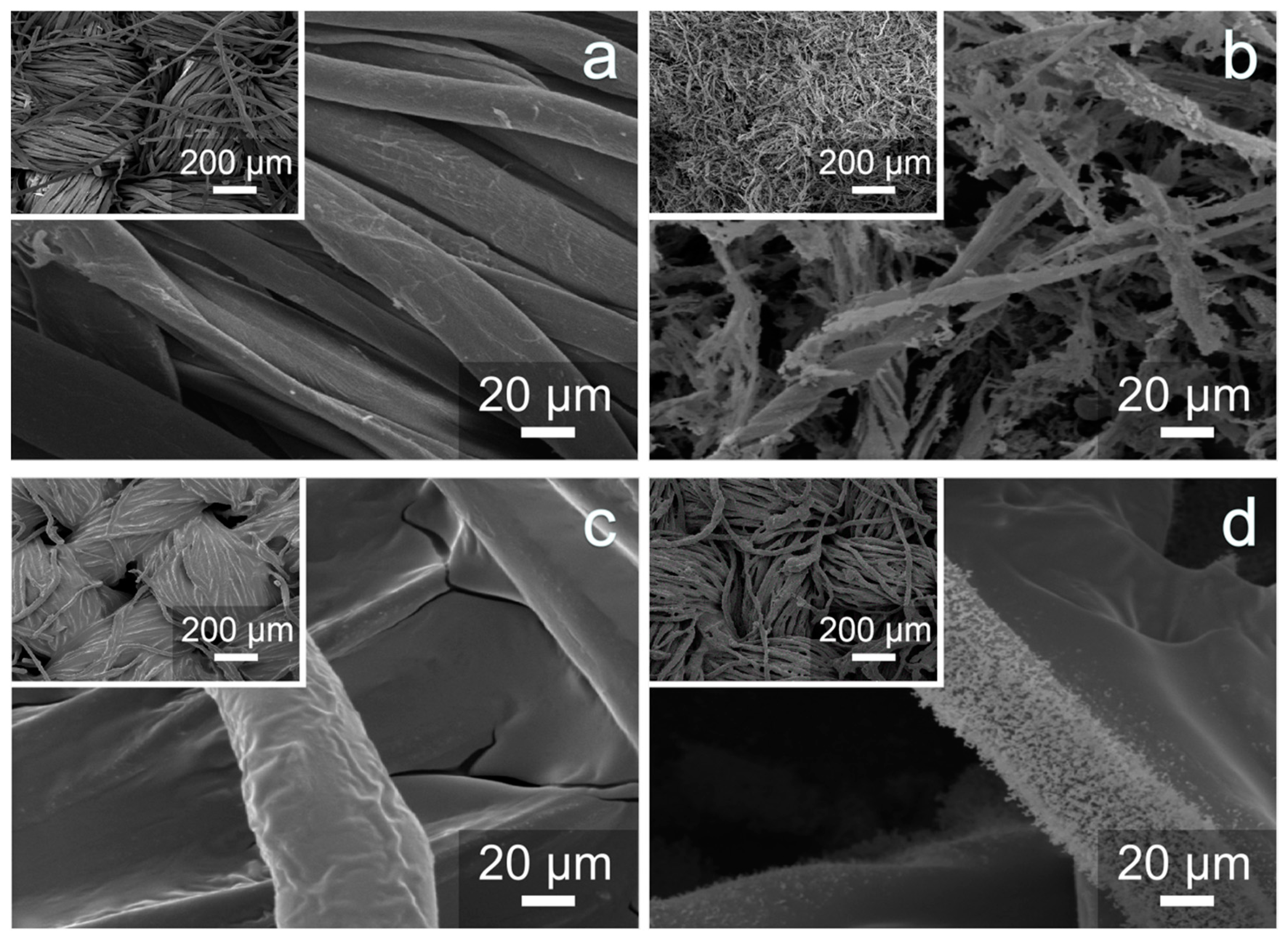
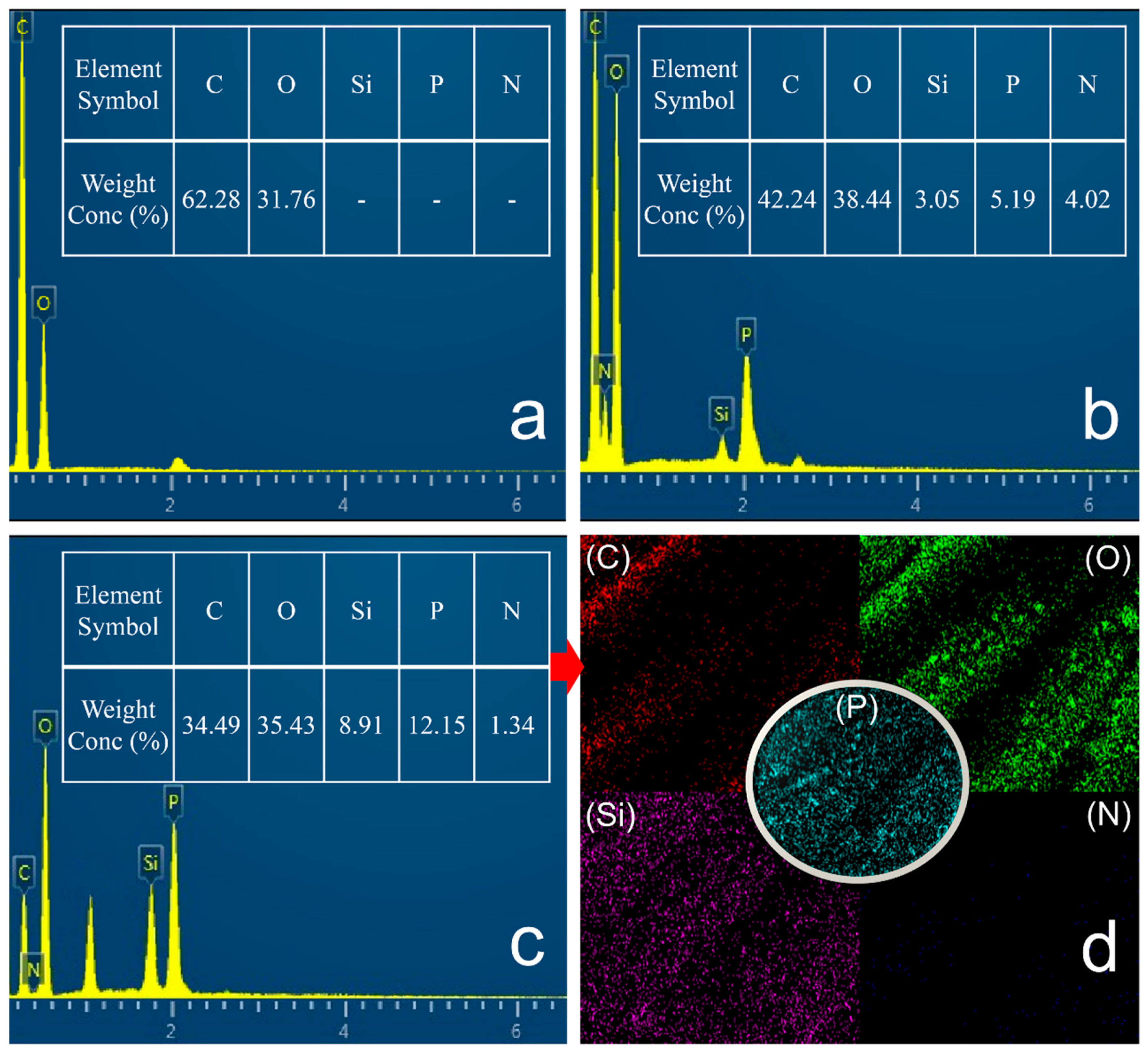


| CPN-PDMS (g/L) | WG (%) | LOI (%) | Vertical Burning Test | Whiteness (%) | Tensile Strength | |||
|---|---|---|---|---|---|---|---|---|
| After-Flame Time (s) | After-Glow Time (s) | Char Length (cm) | Warp (N) | Weft (N) | ||||
| 0 | 18.0 | - | - | 30 | 83.79 | 647 | 319 | |
| 200 | 10.5 | 27.5 | 0 | 4.6 | 18.6 | 83.10 | 614 | 303 |
| 250 | 15.3 | 28.1 | 0 | 2.2 | 12.9 | 82.62 | 606 | 298 |
| 300 | 22.8 | 29.5 | 0 | 1.3 | 8.2 | 81.39 | 593 | 292 |
| 350 | 27.1 | 30.6 | 0 | 0 | 4.3 | 81.17 | 585 | 287 |
| 400 | 31.0 | 31.1 | 0 | 0 | 3.9 | 78.45 | 562 | 273 |
| Finishing Agent Dosage (g/L) | Tonest (°C) | Tmax1 (°C) | Tmax2 (°C) | Residue (%) | |
|---|---|---|---|---|---|
| Tmax1 (°C) | 700 °C | ||||
| 0 | 282.4 | 347.1 | 473.4 | 61.56 | 1.46 |
| 350 | 171.2 | 256.3 | - | 58.42 | 29.13 |
| Samples | TTI (s) | PHRR (kW/m2) | PEHC (MJ/kg) | Average EHC (MJ/kg) | CO (kg/kg) | CO2 (kg/kg) | CO2/CO |
|---|---|---|---|---|---|---|---|
| Pure cotton fabrics | 2 | 118.9 | 33.56 | 8.69 | 0.08 | 1.82 | 22.75 |
| Treated cotton fabrics | 32 | 66.1 | 10.93 | 2.08 | 0.15 | 1.17 | 7.8 |
| Laundering Cycles | Water Repellency Grade | CA (°) | LOI (%) |
|---|---|---|---|
| 0 | 90 | 148.2 | 30.6 |
| 5 | 90 | 139.1 | 29.9 |
| 10 | 90 | 133.4 | 29.6 |
| 15 | 80 | 128.2 | 29.4 |
| 20 | 80 | 124.9 | 29.0 |
| 25 | 80 | 121.3 | 28.8 |
| 30 | 80 | 118.6 | 28.5 |
© 2019 by the authors. Licensee MDPI, Basel, Switzerland. This article is an open access article distributed under the terms and conditions of the Creative Commons Attribution (CC BY) license (http://creativecommons.org/licenses/by/4.0/).
Share and Cite
Dong, C.; Sun, L.; Ma, X.; Lu, Z.; He, P.; Zhu, P. Synthesis of a Novel Linear α, ω-Di (Chloro Phosphoramide) Polydimethylsiloxane and Its Applications in Improving Flame-Retardant and Water-Repellent Properties of Cotton Fabrics. Polymers 2019, 11, 1829. https://doi.org/10.3390/polym11111829
Dong C, Sun L, Ma X, Lu Z, He P, Zhu P. Synthesis of a Novel Linear α, ω-Di (Chloro Phosphoramide) Polydimethylsiloxane and Its Applications in Improving Flame-Retardant and Water-Repellent Properties of Cotton Fabrics. Polymers. 2019; 11(11):1829. https://doi.org/10.3390/polym11111829
Chicago/Turabian StyleDong, Chaohong, Ling Sun, Xingbo Ma, Zhou Lu, Pengshuang He, and Ping Zhu. 2019. "Synthesis of a Novel Linear α, ω-Di (Chloro Phosphoramide) Polydimethylsiloxane and Its Applications in Improving Flame-Retardant and Water-Repellent Properties of Cotton Fabrics" Polymers 11, no. 11: 1829. https://doi.org/10.3390/polym11111829
APA StyleDong, C., Sun, L., Ma, X., Lu, Z., He, P., & Zhu, P. (2019). Synthesis of a Novel Linear α, ω-Di (Chloro Phosphoramide) Polydimethylsiloxane and Its Applications in Improving Flame-Retardant and Water-Repellent Properties of Cotton Fabrics. Polymers, 11(11), 1829. https://doi.org/10.3390/polym11111829





